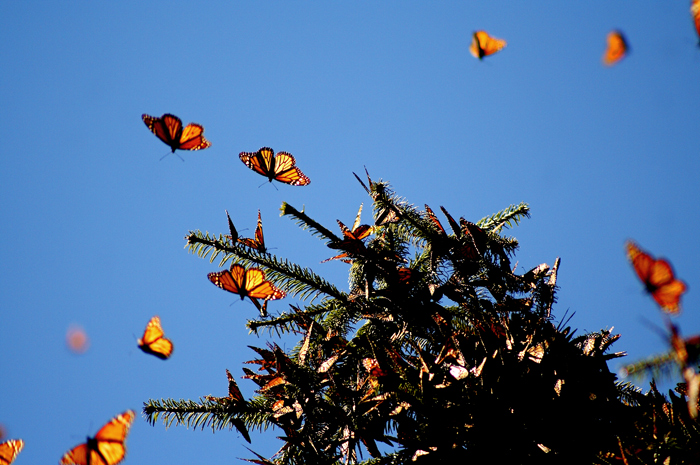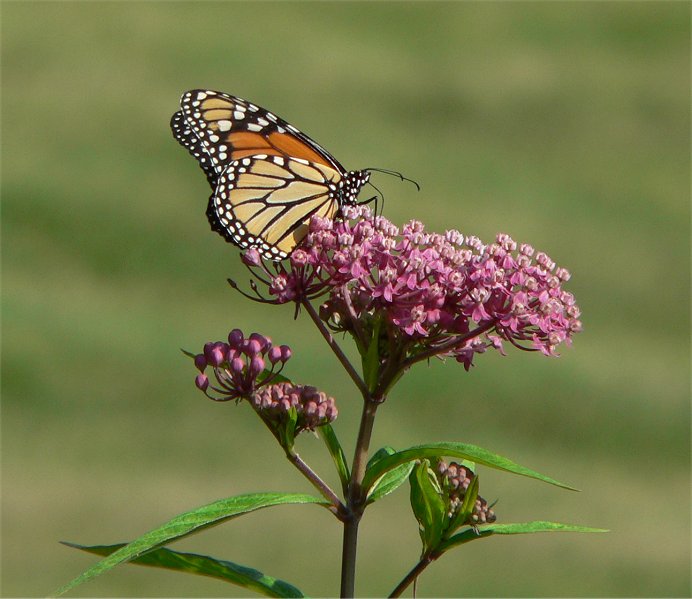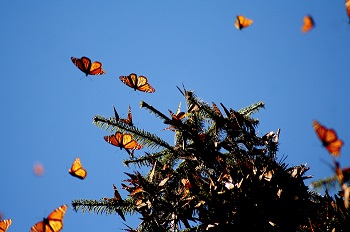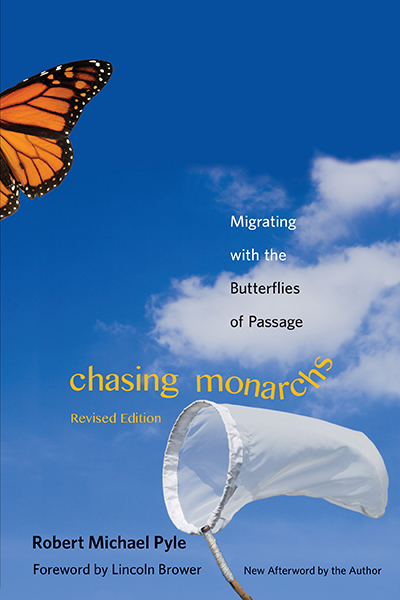The Death of the Monarch Butterfly
Robert Michael Pyle—
Many people will have greeted the news that the monarch butterfly has been proposed for listing under the Endangered Species Act with bewilderment, if not incredulity. How can this icon among American butterflies, once proposed in Congress as our National Butterfly, this common companion of childhood for generations, possibly be threatened with extinction?
It is true that the immediately recognizable, citrus-orange glider we call the monarch has been almost ubiquitous in many parts of the continent for much of the past century, and likely long before. But its numbers on the famous overwintering grounds in Mexico last winter were fewer than 10 % of what they were in the 1990s, and its breeding habitat in the Midwest—the breadbasket of monarchs—has been reduced by millions of acres in recent years. The petitioning parties are the Center for Biological Diversity, the Center for Food Safety, the Xerces Society for Invertebrate Conservation, and Professor Lincoln P. Brower, of Sweet Briar College. You can read many more details in their press release.

Monarch butterfly migration, via Wikimedia Commons.
The entire species Danaus plexippus is not in equal jeopardy everywhere it occurs. But the main subspecies, D. plexippus plexippus, is certainly at risk as a whole. Introduced populations from Hawaii to Australia are subject to fluctuation and a variety of extinction factors as well as genetic isolation, and could not be counted on to restore the native North American population if it drops out. Nor could the non-migratory populations that occur in parts of the Neotropics and are vulnerable to drought, development, and many other threats. The core of the species, and the core concern, is also the grandest butterfly spectacle in the world: the migratory North American monarchs. These were declared a threatened phenomenon almost thirty years ago by Professor Brower and myself, in the IUCN Invertebrate Red Data Book and elsewhere. However, the subspecies as a whole must now be deemed threatened by extinction, for if the central population goes, the introduced and non-migratory outliers will surely follow eventually. So it’s true: the monarch is in serious trouble. How did this sad state come to pass?
The key lies with the monarchs’ necessary caterpillar food plants: milkweeds, and only milkweeds. For the last century, the monarchs got on fine with the farmers, utilizing harmless milkweed that thrived in the field edges and corners, hedgerows and windrows. But in this century, Monsanto has introduced herbicide-tolerant, genetically modified soy, corn, and other crops, which farmers have little choice but to use, and this binds them into massively increased use of glyphosate herbicide, also manufactured by Monsanto. This expensive and reckless cycle is already generating glyphosate-resistant weeds; but it has also led to the destruction of millions of milkweed plants across the Midwest. And the monarch numbers have plummeted in response. Many now consider “Monsanto” the antonym of “monarch.”

A monarch buttefly on swamp milkweed, via Wikimedia Commons
The listing process will probably be lengthy, involving much debate. So far, most of the monarch scientists and conservationists, including me, support it. If a listing of threatened or endangered species comes about, there may be many repercussions. But the petitioners have taken care to stipulate that ongoing monarch science and citizen science—such as schoolchildren raising wild local monarchs in their classroom, and the tagging of monarchs for migration studies—should not be unduly affected by restrictions Nor should the burden all fall on the farmers. As ethnobotanist and author Gary Nabhan, co-author of The Forgotten Pollinators and co-founder of the consortium Make Way for Monarchs, has written, “Farmers already are, and will continue to be, part of the solution to recover the monarch butterfly populations; much of the milkweed restoration work that has already begun is within our nation’s farmscapes. We hope that a broad spectrum of participants across the entire food supply chain—from fertilizer and herbicide producers to restaurant owners and consumers—will begin to invest in farmers’ efforts to restore habitat for monarchs and other pollinators on private lands.” The listing should help this collaborative process to happen.
A few days after the extraordinarily detailed 159-page monarch petition was lodged with the Department of the Interior, we marked the 100th anniversary of the extinction of the passenger pigeon. There, too, was a hugely abundant organism that no one thought could possibly become extinct. Yet for a variety of reasons, it did. While some may consider monarch listing to be an overreaction or premature, I think of it as a properly cautious use of what I call the Passenger Pigeon Principle: if we don’t do everything we can now to protect and perpetuate our once-abundant wildlife species, they may well become the passenger pigeons of tomorrow.
When the pigeons were finally gone, the skies were wiped clean of these beautiful and valuable birds that once darkened them for hundreds of miles. Shall we also watch our most beloved butterflies, which have always brightened our childhoods and lifted our hearts—Canadians, Mexicans, and Americans alike—be wiped away as well? I, for one, do not want to wait to find out. Listing might or might not make the difference, but it seems the least we can do for monarchs now. And far from being hasty, I only hope we are not too late.
Robert Michael Pyle is an award-winning author of eighteen books, including Wintergreen, for which he received the John Burroughs Medal, and Chasing Monarchs. He is founder of the Xerces Society for Invertebrate Conservation and has worked in every state and many countries as a butterfly ecologist, writer, speaker, and teacher.
























